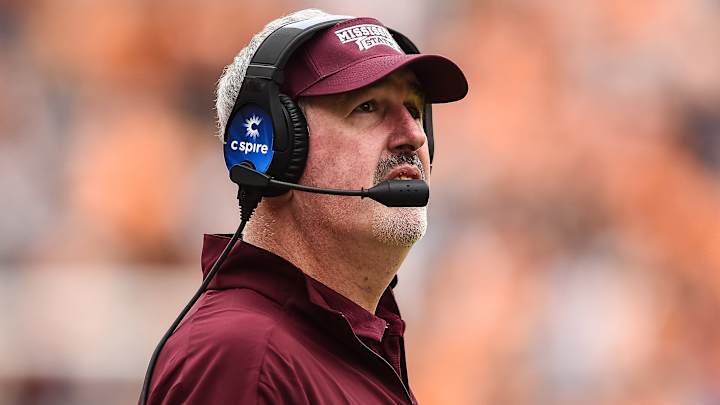As College Football's Win-Now Culture Intensifies, the Leash for Head Coaches Is Getting Much Shorter

Willie Taggart, Chad Morris and Joe Moorhead will forever be linked together for something they’d probably like to forget. They were all fired before coaching the first game of their third season at their respective school.
The timing is important here. Before this season, you’d have to go back more than a decade to find three Power 5 coaches who were dismissed, primarily for on-field performance, before their third year. This year, we got three in a single season, two of them within a week of one another in early November—when Florida State fired Taggart after 21 games and Arkansas fired Morris after 22 games. On Friday, in an unusual move, we got No. 3 when Mississippi State fired Moorhead, the rare coach fired after his bowl game.
State, a program mired in futility before Dan Mullen’s arrival in 2009, fired a coach who was 14-12, had led his team to consecutive bowl games and was 2-0 against bitter in-state rival Ole Miss. There is more to this firing of course, detailed in a Sports Illustrated piece published Thursday night before the firing. For example, season-long discipline issues within the program festered into a fight during a bowl practice that ultimately sidelined starting quarterback Garrett Shrader. However, the bottom line is that Moorhead didn’t win enough games, more specifically he didn’t win the games he should have won, the ones in which his team was favored. That includes the 38-28 loss to Louisville in the Music City Bowl on Dec. 30.
And so after just 26 games, Mississippi State fired a man with as many wins in two years as the Bulldogs had in a five-year stretch from 2002-06. It is the greatest and most recent example of the pressurized, win-now era of college football. “F---ed up business. People are insane,” says one college coach after the news hit. Ignore for a second the off-the-field problems. If a coach at Mississippi State—Mississippi State!—is fired after two years and 14 victories, is college football in a good place? That’s worth a debate. The pressure to win so quickly in the sport—and to look good doing it—is driven by football’s ever-increasing cash flow. Mo’ money, as they say, mo’ problems.
If Coach X is making this many million dollars, he’d better win this many games. If we’ve poured this many millions into fancy new facilities, we’d better win this many championships.
More recently, a new aspect has impacted decisions: fan attendance, something dipping across the country. Administrators are trying to get butts in seats any way they can. That includes renovating their stadiums to add more premium seating, selling beer at games and, of course, hiring coaches to win games with fun, exciting offenses (ahem, the Bulldogs' rival Ole Miss just made a splash by hiring Lane Kiffin).
More than ever, outside influences are impacting coaching decisions. Take, for instance, the snafu at Tennessee two years ago, when a fan-led social media backlash altered the course of a coaching hiring (you do remember the Greg Schiano stuff, right?). Over the last few months, State fans across the internet had not only expressed their disinterest in the football team, but they had at times viciously attacked Moorhead and the athletic director, John Cohen, who privately gave his commitment to the coach following the Egg Bowl roughly a month ago. Cohen is a Mississippi State graduate and a former baseball coach there who is deeply rooted within the Maroon-and-White community. He’s heard the cries about the man he hired to replace Mullen.
The now-Florida head coach impacted this decision from 550 miles away. He set an expectation level in Starkville that few may ever reach. Before Mullen’s arrival, State played in one bowl the previous eight seasons. Go deeper into State’s history and you’ll find a program that had 15 winning seasons in a 50-year stretch starting in 1959 and ending with the start of Mullen’s tenure. In 10 years under Mullen, they had eight such seasons. “The just beat Ole Miss narrative was assassinated this morning,” tweeted longtime Bulldogs insider Steve Robertson. “Mississippi State just fired a coach who beat the Rebels both times he played them and went to two bowl games. It’s a different day and time in Starkville.”
Not just in Starkville but across the nation—Fayetteville, Tallahassee, etc. It wasn’t always like this. Even some of the game’s greats struggled at first. Bill Snyder won six times in his first 22 games before becoming Kansas State’s all-time wins leader. At Iowa, Kirk Ferentz won four games in his first two seasons, and Frank Beamer at Virginia Tech didn’t win more than six games until his seventh season. We aren’t comparing Morris, Taggart and Moorhead to some of these guys, but they are examples of why sometimes the trigger shouldn’t be pulled so soon. Athletic directors usually like to see an improvement from year-to-year, but there was a somewhat unwritten rule in the industry to give a coach at least three years. That appears to be changing.
So too is the price of these decisions. Taggart’s buyout was around $17 million and Morris’s was about $10 million. Moorhead’s buyout is much lower, a source said, about $7 million, but that can be mitigated to as little as $4 million through off-set language in his contract, assuming the coach finds other employment. Meanwhile, a new coach’s contract could cost more than $20 million guaranteed. And then there’s the current and future staffs. Schools must buy out remaining assistant coaching contracts (many coordinators have two to three year deals), and a new staff might cost more than $5 million in guarantees.
And so as 2020 arrives, Mississippi State becomes the latest example of the win-now culture in college football, an industry that might not be as healthy as we’d all like to believe.
